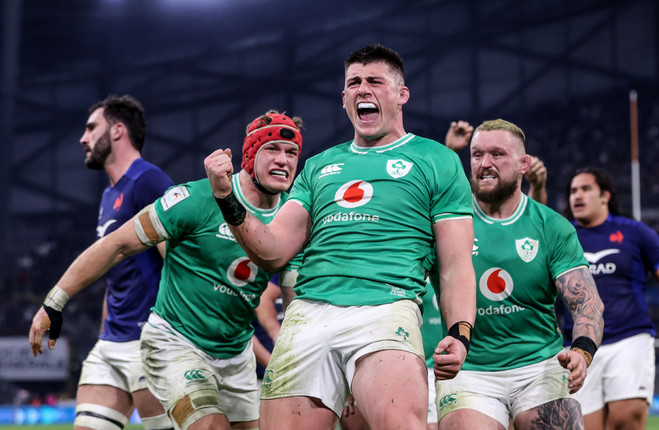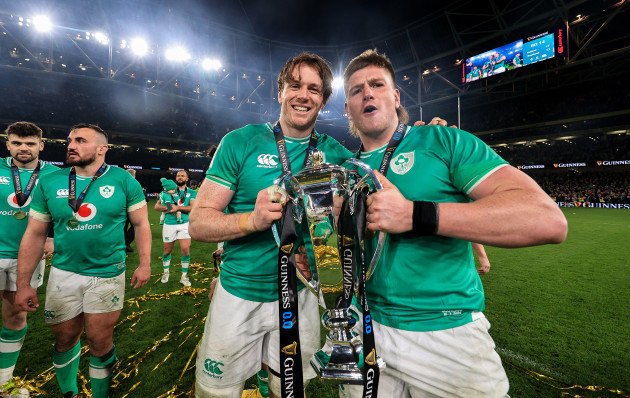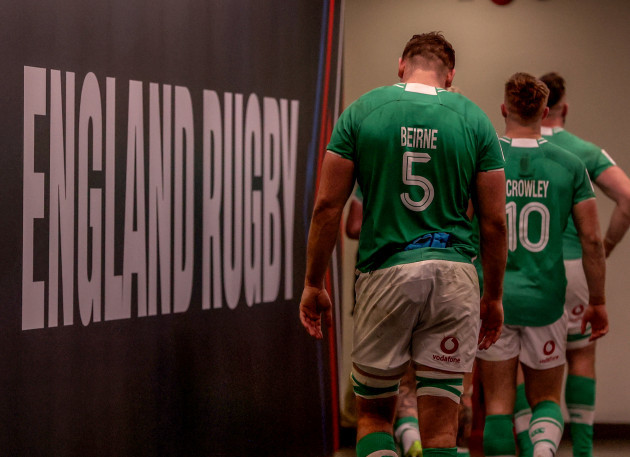HEADING INTO THE opening weekend of the Six Nations in early February, it wasn’t surprising that some Irish supporters and media were getting worried.
Away to France in Marseille. Talismanic captain Johnny Sexton had retired. Mack Hansen, another key creative influence, was missing through injury. Garry Ringrose had gone down too. And the crushing disappointment of the World Cup still seemed so fresh.
As that Friday night showdown drew closer, the predictions of a tough ride for Ireland proliferated. But the anxiety didn’t seem to seep into the Irish set-up. Andy Farrell’s men were composed as they racked up a record winning margin away to the French, scoring five tries in a 38-17 win.
The first-half red card for French lock Paul Willemse was obviously an important factor but there’s no doubt Ireland were seriously on form that evening. France weren’t but it was impressive stuff from Farrell’s side, who didn’t seem to be hungover.
It was the ideal start, creating a wonderful chance to clinch a second consecutive Six Nations title and Ireland haven’t let that opportunity slip. They were close to a Grand Slam but this title is still an excellent achievement.
We saw how France struggled to get on with things after their World Cup dejection. It was obvious how they found it hard to adapt to life without Antoine Dupont.
In contrast, no one seemed to mention Sexton until the past fortnight. This was Ireland’s first Six Nations without him for 15 years. He was the skipper, chief tactical decision-maker, place-kicker, an attack coach in all but name, a defensive leader, and apparently even knew how to lead the party when Ireland were celebrating.
Sexton’s experience and control might have been useful at Twickenham two weekends ago and possibly against Scotland on Saturday, but that is not meant as a slight on Jack Crowley. He has had an impressive first Six Nations as Ireland’s starting out-half. It has been a much smoother transition than expected, with Crowley adding classy touches in attack and Sexton-esque desire to defend.
Still only 24, he will have learned hugely from playing every minute of this Six Nations campaign. Crowley is a player who reviews games in extreme depth and he will have reconsidered every decision he made over the past two months. He’ll have studied the execution of his own skills but also the plays he called for his team. Crowley will get better but he’s already building off a strong base.
“Jack’s a realist,” said Ireland boss Farrell on Saturday night. “And do you know what? I’ve been hard on him, we have.
“Jack will tell you that because it’s easy to read the press with you guys and get carried away that, you know, ‘I’m doing it and I am doing really well.’
“But we’ve kept his feet on the ground and Joe McCarthy as well and people like that because there has to be a realisation that that is not it, that’s not what we are chasing.
“We are chasing something better than that and as long as we can continue to do that, we’ll continue to grow as a group.”
22-year-old lock McCarthy has assumed first-choice status in this championship and added a notable edge. He is already winning important physical battles for Ireland and showing glimpses of his ever-improving handling skills. The exciting thing is that he still has plenty of polishing to do in his game.
With Hansen and Jimmy O’Brien absent through injury, as well as the highly influential Keith Earls having retired, Calvin Nash has had a strong Six Nations on the right wing. There have been slick touches like his assist for James Lowe against Wales and a one-handed offload to Bundee Aki last weekend, while the Munster man has brought eye-catching aggression in contact and accuracy in less glamorous areas like restart chase.
Ireland have missed the intuitive decision-making Hansen brings to the mix but Nash is now a fully-fledged Test wing who ensures crucial competition out wide when there had been worries about Ireland’s depth.
Injury for Hugo Keenan means Ciarán Frawley has now started a Test at fullback and though Jordan Larmour was sprung into action at late notice last weekend after another injury for Keenan, it means Farrell’s side have experienced what it’s like without their world-class fullback.
This wasn’t a completely new-look Ireland side for the 2024 Six Nations but it certainly was remodelled.
Having started strongly away to the French, there was another good performance from Ireland in Round 2 as they hammered Italy 36-0. The Italians went on to draw with France then beat Scotland and Wales, having lost to England by just three points before Ireland shredded them.
The six-try win came despite Farrell making six changes to Ireland’s starting XV. That’s why he reckons it might have been Ireland’s best display of this championship.
“I actually probably look at the Italy game as a… I mean, look at what’s happened since with Italy and their performances and the changes in personnel we had and how we got the bonus-point win from that.
“It says a lot about the group, you know. So that pleased me most really because it has been a group effort and it’s what we pride ourselves on as far as our preparation, as far as people being disappointed, not getting to take to the field.”
Only three players in Ireland’s wider Six Nations squad – Nick Timoney, Tom Stewart, and Jacob Stockdale – didn’t feature in matchday 23s, while Munster man Tom Ahern spent time as part of the squad but remains uncapped.
Farrell used 32 players in this Six Nations, with McCarthy, Nash, Frawley, Jeremy Loughman, Harry Byrne, and Oli Jager making their championship debuts. Jager’s appearance off the bench against Wales was his first Test cap as Farrell added another option to his tighthead depth chart.
Crowley, Lowe, and Caelan Doris were the only players to complete all 400 minutes of this Six Nations, with Lowe having done the same during last year’s Grand Slam campaign.
This time around, Robbie Henshaw [383 minutes], Bundee Aki [320], Andrew Porter [318], McCarthy [317], and Tadhg Beirne [310] were also heavily relied upon.
Round 3 saw Ireland overcome Wales in a bonus-point win that featured some fine rugby before the Grand Slam dream died at Twickenham.
Ireland admitted to being a fair way off their peak and England delivered their best showing since the 2019 World Cup. Despite being outplayed, Farrell’s men could still have won that match if they’d managed the endgame better. Overall, it was the kind of dip that underlines why Grand Slams are so hard to win. Being good enough to win five Test matches against five other top rugby nations in a short space of time is difficult, even more so when you’ve a target on your backs like Ireland do these days.
Ireland didn’t get to their peak for the win over Scotland either but they did play some fine stuff at times. It was Irish pressure that put the Scots in a tough spot for Dan Sheehan’s first-half try before a poor second quarter from Ireland.
Farrell’s men started the second half strongly and it looked like Tadhg Furlong had scored in the 48th minute. Had they gone 17-6 up at that stage, Ireland might have kicked on nicely. Instead, they had more frustration with two knock-ons metres out from the Scottish tryline from Nash and Ringrose, as well as Henshaw being held up. Finally, Porter smashed over from a clever five-metre tap play. So much of the work to get into those positions was good from Ireland and major credit is due to Scotland for an outstanding defensive performance.
Ireland had the most effective attack in this championship. Their 19 tries had them six ahead of the next best, while their tally of 36 linebreaks is eight more than anyone else. Hooker Dan Sheehan led the way with five tries, while Lowe bagged four.
On the other side of the ball, Ireland conceded seven tries, which was six fewer than next-best Scotland and England. They were also the stingiest in terms of linebreaks conceded with 19. Only Italy made more breakdown steals than Ireland.
There were frustrating moments for the Irish lineout but they ended up joint-top with England on 91% of their lineouts won, according to Opta. Ireland were also joint-top for steals on the opposition throw with five.
The Irish maul did crucial damage in this championship, including two tries against the French. In total, 15 of Ireland’s 19 tries started with their throw-in to the lineout. 79% of the Irish tries coming from lineouts was much higher than the other teams.
Ireland’s 93% success at their own scrum was the highest in the Six Nations. While the Irish scrum conceded eight penalties and two free-kicks, it also won seven penalties and five free-kicks.
Seven of Ireland’s eight scrum penalty concessions came on the opposition feed, so that’s a clear focus for improvement.
Ireland’s discipline was poor even if they ended the campaign by conceding just four penalties against Scotland. Overall, Farrell’s men gave up 49 penalties, more than everyone else except the Scots [57], and were yellow-carded five times. Excellent discipline had been a calling card for Ireland but it slipped in this Six Nations.
Yet Ireland had the quality and class to become champions again as they enthusiastically stepped into the latest chapter for this team, the one without Sexton.
Peter O’Mahony was the man to succeed him as skipper and though the Munster back row has had bigger influences on previous Six Nations campaigns purely as a player, Farrell has been delighted with the Cork man’s guidance along with other leaders.
“When I constantly talk about doing it together, honestly if you were in camp with Pete you’d realise what it’s all about really,” said Farrell.
This championship has been another big success for Farrell, who will have learned plenty himself. The 6/2 bench split worked well against France and Wales but its risks were highlighted away to England. Farrell and his coaches will review their technical and tactical preparation of the players but also the mental side of things, which performance coach Gary Keegan has a major influence over.
Ireland know better than anyone that it hasn’t been a perfect Six Nations but it has been an excellent one nonetheless. History highlights that it’s worth celebrating for Irish fans. This is just Ireland’s 16th outright championship success in 130 attempts.
The IRFU will be thrilled with the prize money, believed to be in the region of €3.5 million, given how essential a successful senior men’s Ireland team is in keeping the entire Irish rugby system afloat.
There are exciting challenges to come this summer and autumn but 2024 has already been a positive year with the bread-and-butter business of chasing Six Nations glory taken care of.
In 2025, Ireland will have a shot at becoming the first team in history to win three championships in a row, with fixtures against England and France at home. Farrell will be with the Lions by then but he signed off from Six Nations duty in a happy place.





